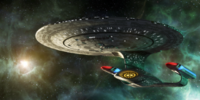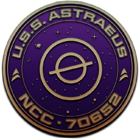Astraeus Specifications
Jump to navigation
Jump to search
| USS Astraeus | |||||||||||||
|---|---|---|---|---|---|---|---|---|---|---|---|---|---|
 ACTIVE STATUS | |||||||||||||
| |||||||||||||
USS Astraeus NCC-70652
Specifications
- Name: USS Astraeus (Greek Titan of the Dusk)
- Registry: NCC-70652
- Class: Galaxy class
- Category: Explorer
- Motto: “Hope is the thing with feathers, that perches in the soul. And sings the tune without the words, and never stops at all.” - Emily Dickinson
- Length: 648.33 meters
- Width: 461.21 meters
- Height: 195.98 meters
- Mass: 4,705,505 metric tons
- Number of Decks: 42
- Strength Index: 2092.274
Crew
- Complement: 1,291
- Officers: 350
- Enlisted: 814
- Civilians: 127
- Evacuation Capacity: Approximately 15,000
Scientific Facilities
- Science Division: With hundreds of biological and physical science labs located throughout the primary hull and engineering and mechanical laboratories in the stardrive section, the Astraeus is one of the most capable scientific research vessels in Starfleet, outside of dedicated science vessels. The ship's new bio-neural computer systems allow for extremely rapid computation and problem solving, and her hundreds of scientific crew members and officers are supplemented by some of the most prominent civilian scientists in their fields.
Crew Support Systems
- Medical: Primary sickbay located in the saucer section, with multiple wards, surgical suites, intensive-care units (ICU), biohazard support, morgue and several medical laboratories, equipped with specialized equipment for researching pandemic-scale medical events. Secondary sickbay located in the stardrive section with similar, if slightly smaller facilities.
- Holographic Support: Emergency Medical Holographic Emitters installed in all medical facilities, as well as important crew gathering locations, such as Ten Forward, the Bridge, Engineering, and others.
- Education: Nursery, K-12 classrooms, and others. Some facilities for university and Starfleet training for acting Ensigns are available.
- Recreational: 16 holodecks (25 man capacity), mess hall, crew lounge, gymnasium and additional reconfigurable recreational halls.
Engineering
- Warp Engines: One 1,500+ Cochrane warp core feeding two LF-41 Mod 3 advanced linear warp drive units
- Quantum Slipstream Drive: Yes; limited use for emergencies and long range travel only.
- Impulse Engines: Three FIG 5 Subatomic Unified Energy Impulse Units, two located on the saucer section, one on the stardrive section.
- Speed:
- Cruising: Warp 8 / 1024 times the speed of light
- Maximum Sustainable Cruise: Warp 14 (6,753 times the speed of light / Warp 9.985 in TNG scale)
- Maximum / Emergency: Warp 15 for 12 hours (8,323 times the speed of light / Warp 9.9913 in the TNG scale)
- Computer System: LCARS, Class XIX Bioneural processing units, three independent computer cores
Maintenance
- Expected Duration: 100 years
- Resupply Cycle: 1 year
- Minor Refit Cycle: 5 years
- Standard Refit Cycle: 10 years
- Major Refit Cycle: 20 years
Armament
- Beam Weapons:
- Sixteen Type XII collimated phaser arrays. One array is located on the stardrive section and can only be used when the ship is separated.
- Output: 85,000 TeraWatts
- Torpedo Launchers:
Four Mk 95 pulse-fire torpedo tubes. One rearward-facing launcher is located on the saucer section and can only be fired when the ship is separated.
- Payload: 200 quantum torpedoes fore, 100 aft. The Astraeus has the capability to construct new torpedoes, assuming proper resources are available.
Defensive Systems
10 high capacity, regenerative oscillating subspace graviton field grids with recursive response analysis.
- Shield Capacity: 5,750,000 TeraJoules
- Armor Type: Duranium / Tritanium double layered hull, with 10 cm of ablative armor.
Transporter Systems
- Personnel: 8 transporter rooms with a 6 man capacity per transporter.
- Cargo: 6 cargo transporters with a 5 metric ton capacity per transport.
Cargo Systems
- Total Capacity: Mission dependent. Several sections of the Galaxy class are designed to be highly reconfigurable and can be easily rededicated according to mission requirements.
Auxiliary Spacecraft Systems
- Approximate Auxiliary Craft Complement: 65
- Shuttlepods: 12
- Personal Shuttles: 10
- 5 Type IX short range shuttles
- 5 Type XI long range shuttles
- Runabouts: 2 Arrow class runabouts
- Cargo Shuttles: 10
- Specialist Craft: 31
- 1 Captain's Yacht
- 10 Sphinx Workpods
- 20 Workbees
- Emergency Evacuation Systems/Escape Pods: 2700 Type IX Autonomous Survival and Recovery Vehicles (ASRV)











